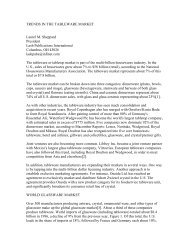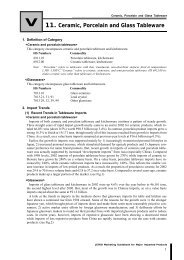eu market survey 2003 - crecer
eu market survey 2003 - crecer
eu market survey 2003 - crecer
Create successful ePaper yourself
Turn your PDF publications into a flip-book with our unique Google optimized e-Paper software.
5.2 Import by product group<br />
In this paragraph we will discuss the import per<br />
product group. In the figure attached to each<br />
product group, the quantitative developments<br />
are put down. The size of the circle indicates the<br />
size of the import <strong>market</strong> in terms of value. On<br />
the vertical axe you will find the import<br />
development in value in the year 2001. The<br />
horizontal axe gives to an indication of import<br />
development between 1997 and 2001 in terms of<br />
volume. We have used volume figures instead of<br />
value figures to indicate the long term<br />
development. The main reason for using the<br />
volume figures instead of the value figures is<br />
that the value figures deriving from Eurostat are<br />
How to read the graphics in paragraph 5.2:<br />
Example: Figure 5.9 indicates that the German<br />
import of metalware is the biggest metal import<br />
<strong>market</strong> in de EU in 2001 (size of the circle). In<br />
2001, the German import decreased by almost<br />
8 percent in terms of value (vertical axe). In the<br />
period 1997 till 2001, the German import<br />
<strong>market</strong> increased by only 3 percent in terms of<br />
volume (horizontal axe).<br />
Conclusion: Apart from strong fluctuations in<br />
import figures, the German import as a whole<br />
seems to be quite stable reflected by the long<br />
term growth of only 3 percent (volume).<br />
not corrected for inflation. Because the inflation differs from country to country, using the value<br />
figures to indicate import developments especially long terms ones, could lead to wrong<br />
assumptions. Additional information can be found in Appendix 2.<br />
Metalware<br />
In 2001, metalware was the leading product group imported by the EU-countries, representing a<br />
value of € 2.0 billion and a volume of 419,000 tons. In 2001, the imported value showed a small<br />
decline of 1 percent, whereas the volume dropped by 3 percent. Over the period between 1997<br />
and 2001, the import of metalware grew by 23 percent in value and 19 percent in volume. In<br />
Figure 5.9, we can see that Germany, the biggest import <strong>market</strong>, accounting for almost a quarter<br />
of the EU imports, declined in terms of value (vertical axis) in 2001. Over the period 1997 to<br />
2001, the German import of metalware in terms of volume only grew by 3 percent (horizontal<br />
axis). In 2001, the import volume even dropped by 9 percent. The United Kingdom is becoming<br />
more important, accounting for 19 percent of the EU imports. In 2001, the United Kingdom<br />
showed the most growth, as the import of metalwares increased by 11% in terms of value and 7<br />
percent on a volume basis. Other important import <strong>market</strong>s are France (13%), the Netherlands<br />
(8%), Belgium (8%), Spain (8%), Italy (5%) and Austria (4%).<br />
Figure 5.9<br />
Relative attractiveness of EU-countries with respect to the import development of<br />
metalware<br />
20%<br />
% growth 2001 in €<br />
15%<br />
United Kingdom<br />
10%<br />
Belgium/ Luxembourg<br />
Finland<br />
5%<br />
Netherlands<br />
Sweden<br />
Denmark<br />
Ireland<br />
0%<br />
Austria<br />
France<br />
-15% -5% 5% 15% 25% 35% 45% 55%<br />
-5% Portugal<br />
Italy<br />
Greece<br />
Germany<br />
-10%<br />
-15%<br />
-20%<br />
Spain<br />
% growth 1997 - 2001 in volume<br />
Source: Eurostat, 2002<br />
40





